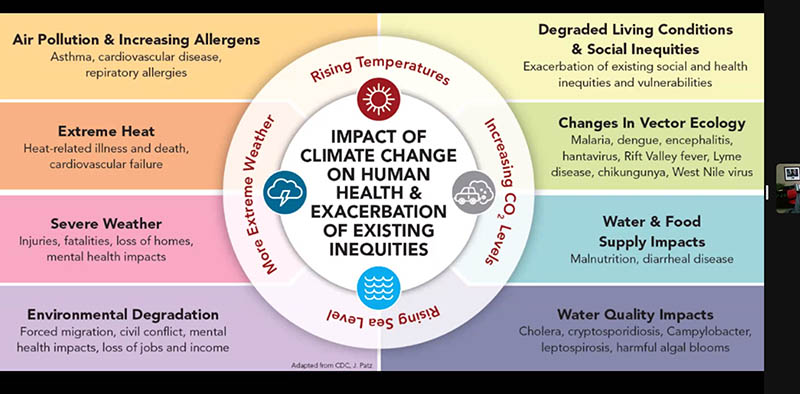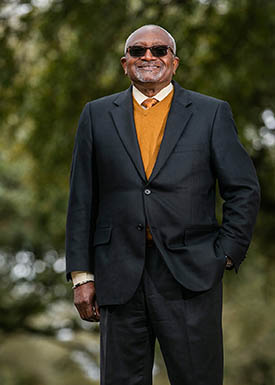Why Climate Change Is a Health Threat
NIH’s New Climate Change and Health Initiative Explores the Risks
Since 1912, the snow on Mount Kilimanjaro in Tanzania has melted more than 80%. Widespread scientific consensus informs us the Earth’s climate is changing, as evidenced by increased global temperatures, warming oceans, and shrinking ice sheets. These climate drivers are bringing about new health risks: Increasing severity and frequency of heat waves leads to more heat-related illnesses and deaths; expanding ranges of disease-carrying insects pose a greater threat to humans; increased exposure to pollen, mold, and other pollutants can worsen allergies and lung diseases such as asthma; higher temperatures can contribute to poor air quality that can exacerbate cardiovascular disease; more flooding events and sea level rise can contaminate water with harmful bacteria, viruses, and chemicals; and more frequent and severe weather events can cause injuries, illness, and even death.

Having noted the implications that climate change has on people’s health, NIH developed the NIH Climate Change and Health Initiative to better understand the relationship between climate change and health, reduce health threats from climate change, and build health resilience in individuals, communities, and nations. The National Institute of Environmental Health Sciences (NIEHS) is leading this multi-institute collaborative effort that, in addition to NIEHS, involves the Fogarty International Center, National Institute of Minority and Health Disparities, National Institute of Mental Health, National Institute of Nursing Research, Eunice Kennedy Shriver National Institute of Child Health and Human Development, and the National Heart, Lung, and Blood Institute. Furthermore, this initiative includes a seminar series, held virtually. Two of the seminars, both held in February 2022, are described here: One featured Robert Bullard (Texas Southern University, TSU, in Houston); the other was a joint presentation by Jonathan Samet (Colorado School of Public Health in Aurora, Colorado) and Tami Bond (Colorado State University, CSU, in Fort Collins, Colorado).
Feeling the pain

COURTESY OF ROBERT BULLARD, TSU
Robert Bullard (Texas Southern University) spoke on “Why Climate Change is a Health Threat,” as part of the NIH Climate Change and Health Initiative lecture series.
In his February 9 talk, Bullard, considered the “Father of Environmental Justice,” spoke on “Why Climate Change is a Health Threat.” He is a distinguished professor of urban planning and environmental policy and the founding director of the Bullard Center for Environmental and Climate Justice at TSU. He is also the award-winning author of 18 books. Early in his career, he played an instrumental role in the 1979 Bean v. Southwestern Waste Management Corp., the first case under civil rights laws that charged environmental discrimination in the siting of a waste facility that was destined for a neighborhood that was more than 80% Black.
Bullard stressed the importance of understanding the geography of inequality and how ZIP Codes can be powerful predictors of health. While historically, people of color and low-income households have contributed least to climate change, they feel the pain the earliest, the most, and the longest.
Compared with whites, people of color receive less FEMA aid after a natural disaster, tend to live in areas that have a greater risk of flooding, are more likely to die from extreme heat, suffer from more air pollution, and are more apt to live in nature-deprived areas. Bullard currently serves on the advisory council of the President’s Justice40 initiative, which seeks to deliver 40% of climate investment benefits to disadvantaged communities.
On February 22, Samet and Bond spoke about “Climate Change, Air Pollution, and Health: What Lies Ahead?” Samet, the dean of and a professor at the Colorado School of Public Health, is a pulmonary physician and epidemiologist and investigates the health risks of inhaled pollutants and how they are linked to respiratory diseases and cancer. Bond is an engineer and the Walter Scott Jr. Presidential Chair in Energy, Environment, and Health at CSU. Her research focuses on combustion, atmospheric chemistry and climate, and the relationship between technology and human choice.
Accelerating climate change

Jonathan Samet (Colorado School of Public Health), left, and Tami Bond (Colorado State University) spoke about “Climate Change, Air Pollution, and Health: What Lies Ahead?”
In their presentations, Samet and Bond highlighted the significance of health-effects research and intervention science. They described how increased air pollution (particulate matter, ozone, nitrogen dioxide) may be due to increased energy use that comes from rising temperatures and urbanization and the effect of temperature itself, which drives up ozone production. As urban areas grow, more people will be living in polluted environments and those with fewer resources will be trapped in those harmful locations and will be challenged to adapt. Samet and Bond stressed the importance of understanding how air pollution, the climate, and the natural world exist in a complex feedback system.
In the current Anthropocene epoch (this most recent period in which people started to have a significant impact on Earth’s climate and ecosystems), human activities are accelerating climate change at a pace never before seen. Combustion pollutants from the burning of fuels such as wood and natural gas can cause eye, nose, and throat irritation, lung disease, cancer, and cardiovascular and respiratory diseases. Samet and Bond acknowledged that although fixing the climate is a daunting task, we must start somewhere. They emphasized the need to continue efforts to clean up combustion pollutants and seek cleaner forms of energy such as solar power. We must also look at climate change through lens of justice and health equity, understand the environmental conditions that patients face, and support community groups all over the country to create a more sustainable future.
To read more about the NIH Climate Change Initiative, visit https://www.nih.gov/climateandhealth. In addition, you will find more information at https://www.niehs.nih.gov/health/topics/agents/climate-change/index.cfm. To view videocasts of these talks (“Why Climate Change Is a Health Threat,” on February 9, 2022; “Climate Change, Air Pollution, and Health: What Lies Ahead?” on February 22, 2022) and others in the seminar series, go to https://www.niehs.nih.gov/research/programs/geh/events/index.cfm.

Raghuram Reddy is a postbaccalaureate fellow in Desmond Brown’s lab in the National Institute of Neurological Disorders and Stroke, where he is analyzing the role of primary cilia in Parkinson disease and glioblastoma. When he completes his fellowship in 2022, he plans to attend medical school. Outside of work, he enjoys playing sports, taking photos, and hiking.
This page was last updated on Tuesday, May 17, 2022
